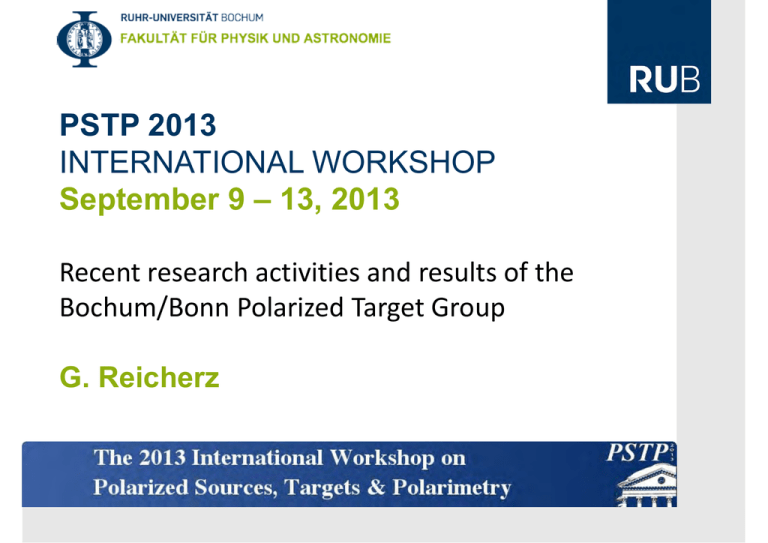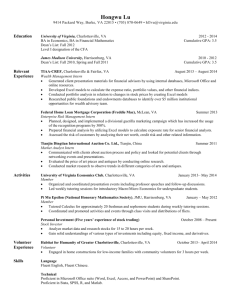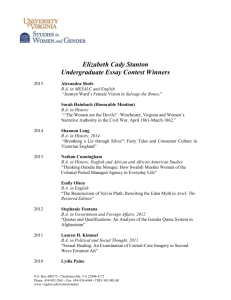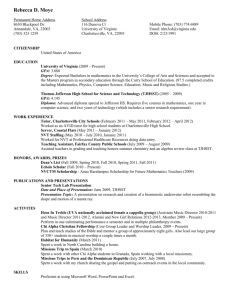PSTP 2013 INTERNATIONAL WORKSHOP September 9 – 13, 2013 Recent research activities and results of the
advertisement

PSTP 2013 INTERNATIONAL WORKSHOP September 9 – 13, 2013 Recent research activities and results of the Bochum/Bonn Polarized Target Group G. Reicherz Content Introduction Bonn Frozen Spin Target Internal magnet development t1e measurements Material progress Bochum NMR box Summary Gerhard Reicherz | PSTP 2013 INTERNATIONAL WORKSHOP | Charlottesville | 09. – 13. September 2013 2 Introduction Focus : Study of the nucleon resonance region (baryon spectroscopy) at ELSA by measuring single and double polarization observables Polarized beam + polarized target + 4 detection system Structure mapping at ELSA Model independent partial wave analysis Complete experiment Photon unpolarized linearly circularly Target (‐) x y z 0 H F T (‐P) 0 0 (‐G) (‐E) Gerhard Reicherz | PSTP 2013 INTERNATIONAL WORKSHOP | Charlottesville | 09. – 13. September 2013 3 Bonn Frozen Spin Target Frozen spin target + internal holding coil Polarizing magnet Bp=2.5 T Horizontal dilution refrigerator (T 50 mK) with internal ‘longitudinal’ or transversal holding coil (BT/L 0.5 T ‐1 T) Polarizing mode DNP ‘continuous mode’ PD/p 80 – 90 % Data taking (frozen spin) mode 300 – 1000 h Large angular acceptance (0.98*4) complex handling (moving) system Gerhard Reicherz | PSTP 2013 INTERNATIONAL WORKSHOP | Charlottesville | 09. – 13. September 2013 4 Bonn Frozen Spin Target Frozen spin target + internal holding coil Frozen spin technique limitations: • Large acceptance target system requires dedicated railway system • FoM 2 nT f P Combine advantage of the frozen spin technique with the advantage of a continuous polarization 2 4 – continuous mode target with internal polarizing magnet Gerhard Reicherz | PSTP 2013 INTERNATIONAL WORKSHOP | Charlottesville | 09. – 13. September 2013 5 Internal magnet development Idea: reduce the magnetic volume of the large external pol. magnet to the size/dimensions of the internal holding coil field strength: 2.5 T as thin as possible (minimized absorption) 2 mm homogeneity dB/B 10‐3 B 0 N Il NC: ampere‐turn : NI 300 kA superconducting wire necessary High current operation (100 A) in a dilution refrigerator Gerhard Reicherz | PSTP 2013 INTERNATIONAL WORKSHOP | Charlottesville | 09. – 13. September 2013 6 Internal magnet development Why do we need a homogeneity of 10‐4< B/B < 10‐3 Depending on material and radical a homogeneity < 10‐3 is needed 10‐4 10‐3 DNP requires separation of the nucleon spin levels NMR in a 4‐layer holding coil (uncorrected solenoid B/B 10‐3) Gerhard Reicherz | PSTP 2013 INTERNATIONAL WORKSHOP | Charlottesville | 09. – 13. September 2013 7 Low‐T refrigerator with high current leads Bochum/Bonn Horizontal dilution refrigerator incl. internal polarizing magnet opt. run as ‚frozen spin target‘ • A 'continuous mode' operating target with large angular acceptance (~4). • Tmin30 mK, Tcontinuous200 mK @ 100 mW. • High luminosity L 1033/cm²s (N 1010/s). • High mean polarization. • Equipped with an internal superconducting polarizing magnet for permanent DNP and high current leads. Gerhard Reicherz | PSTP 2013 INTERNATIONAL WORKSHOP | Charlottesville | 09. – 13. September 2013 8 Low‐T refrigerator with high current leads Bochum/Bonn • Construction of the heat exchangers/components nearly completed • Low temperature heat exchangers under construction at Dubna • First cold test in short time Gerhard Reicherz | PSTP 2013 INTERNATIONAL WORKSHOP | Charlottesville | 09. – 13. September 2013 9 Design of low mass polarizing solenoid 10‐4 < B/B < 10‐3 for the new Bonn refrigerator Fixed Parameters : length 150 mm, 45 mm total thickness < 2 mm Bp= 2.5 T @ Imax< 100A Uncorrected solenoid (B = 2.5T @ 90 A) Gerhard Reicherz | PSTP 2013 INTERNATIONAL WORKSHOP | Charlottesville | 09. – 13. September 2013 10 Design of low mass polarizing solenoid 10‐4 < B/B < 10‐3 for the new Bonn refrigerator corrected solenoid : ‘inverse notched coil’, B = 2.5T @ 90 A • B/B < 10‐4 • 6 layers, 0.25F54 1:1.35, 590 wdg. • 2 corrector notches (2 8 windings) • Thickness 1.8 mm • High accuracy winding is mandatory Gerhard Reicherz | PSTP 2013 INTERNATIONAL WORKSHOP | Charlottesville | 09. – 13. September 2013 11 Design of low mass polarizing solenoid 10‐4 < B/B < 10‐3 for the new Bonn refrigerator corrected solenoid : ‘inverse notched coil’, B = 2.5T @ 90 A for the new refrigerator Gerhard Reicherz | PSTP 2013 INTERNATIONAL WORKSHOP | Charlottesville | 09. – 13. September 2013 12 Prototype production / test of low mass super‐ conducting solenoid for high field Bonn / Mainz First test coils have been wound in Mainz and Bonn • High accuracy layer by layer wet winding has been solved (non standard or commercial technique) • First test coils successfully tested in thermal cycles • First cold test and field measurements at 4.2K have been done at Mainz / Bonn in short time Gerhard Reicherz | PSTP 2013 INTERNATIONAL WORKSHOP | Charlottesville | 09. – 13. September 2013 13 T1e measurements Dzz in a (h:d = 2:1) cylinder First moment Shape factor of the sample Demagnetization factor Frequency shift in hertz Gerhard Reicherz | PSTP 2013 INTERNATIONAL WORKSHOP | Charlottesville | 09. – 13. September 2013 14 T1e measurements (NEDOR) Gerhard Reicherz | PSTP 2013 INTERNATIONAL WORKSHOP | Charlottesville | 09. – 13. September 2013 15 T1e measurements Frequency shift in Hz Paramagnetic relaxation rate C. Hess| NIM A 694 (2012) 69–77 Relaxation via direct process 1/T1e versus bath temperature Evolution to lower temperatures? Gerhard Reicherz | PSTP 2013 INTERNATIONAL WORKSHOP | Charlottesville | 09. – 13. September 2013 16 T1e measurements Rates of electron spin‐lattice relaxation, deuteron spin‐lattice relaxation and deuteron polarization build‐up, as functions of the oxygen content. Temperature dependence Fit function to extract T1e C. Hess| NIM A 694 (2012) 69–77 Gerhard Reicherz | PSTP 2013 INTERNATIONAL WORKSHOP | Charlottesville | 09. – 13. September 2013 17 T1e via line‐broadening Reduced second moment Measurement: Model: m2 P 2 m2 (1 P 2 ) Possible to measure T1e from probes with any shape 6LiD: T 1e 1.5 to 1.8 s Gerhard Reicherz | PSTP 2013 INTERNATIONAL WORKSHOP | Charlottesville | 09. – 13. September 2013 18 The Trityl Radicals — Important progress for deuterated materials Finland D36 (AH110355 deutero acid form) used for butanol‐D10 Ox063 (AH100136 sodium salt) used for propandiol‐D8 Deuteron : up to 79% at 150mK/2.5T Deuteron: up to 81% at 150mK/2.5T Ox063Me (AH 111 501 sodium salt) used for pyruvic acid 13C: up to 74% at 900mK/5.0T W. Meyer, et al., NIM A 631 (2011) 1-5 Gerhard Reicherz | PSTP 2013 INTERNATIONAL WORKSHOP | Charlottesville | 09. – 13. September 2013 19 Important parameter: ESR line width and shape Zeeman Energy of a free electron EZ g e B S B Contributions to the Electron Zeeman line width Etot B ( S gˆ B ) ( S A I ) ED hom in hom Hom. dipol‐dipol interaction between electrons Inhom. hyperfine interaction magnetic nuclei indep. of B0 Inhom. g‐factor anisotropy crystal field dep. of B0 Try to minimize the energy spread Etot • Find a suitable doping method • Try radiation doping if only low μ nuclei present Gerhard Reicherz | PSTP 2013 INTERNATIONAL WORKSHOP | Charlottesville | 09. – 13. September 2013 20 Bochum measurement J. Heckmann, et al., Phys. Rev. B 74 (2006) 134418. Result: The smaller the EPR line width, the higher the deuteron polarization value Gerhard Reicherz | PSTP 2013 INTERNATIONAL WORKSHOP | Charlottesville | 09. – 13. September 2013 21 Development of Polymer Targets Advantages of polymer targets: • • • • Samples can be formed to practically any geometry. Handling of the samples is relatively safe. Samples contain only C and H (D) atoms making the background subtraction more precise. The dilution factor e.g. of polypropylene is slightly higher than that of butanol. • D‐Polyethylene CD2: Paramagnetic centers by irradiation D.G. Crabb, Nucl. Instr. and Meth. A 526,56 (2004) 35 % at 6.5 T/1K • D‐Polystyrene C8D8 : Paramagnetic centers by chemically doping with TEMPO B. van den Brandt et al., Nucl. Instr. and Meth., A536, 53 (2004) 40 % at 2.5 T/100mK Gerhard Reicherz | PSTP 2013 INTERNATIONAL WORKSHOP | Charlottesville | 09. – 13. September 2013 22 Development of Polymer Targets Polyethylene: (CH ) 2 n • Can be classified by density: LLDPE, LDPE, HDPE Polypropylene: (CH - CH - CH ) 2 • • 3 m Can be classified by molecular weight M PP12, PP250, PP580. Initial choice of material was isotactic polypropylene. w Gerhard Reicherz | PSTP 2013 INTERNATIONAL WORKSHOP | Charlottesville | 09. – 13. September 2013 23 Doping of materials : irradiation cryostats Gerhard Reicherz | PSTP 2013 INTERNATIONAL WORKSHOP | Charlottesville | 09. – 13. September 2013 24 Doping of materials: LINAC1 Gerhard Reicherz | PSTP 2013 INTERNATIONAL WORKSHOP | Charlottesville | 09. – 13. September 2013 25 Development of Polymer targets radiation doping • • • • Initial calculation was made for the needed dose: Estimated dose of 1014 e-/cm² is needed. Samples irradiated with 20 MeV e- in argon cryostat at LINAC1 at ELSA. Initial irradiation of material approx. 10 min : Charge injection of 4.19 mC. Radical concentration determined by ESR measurement confirms dose is in correct order of magnitude. Gerhard Reicherz | PSTP 2013 INTERNATIONAL WORKSHOP | Charlottesville | 09. – 13. September 2013 26 Development of Polymer Targets: EPR • The number of peaks in the ESR spectrum is given by (2n1I1 + 1) (2n2I2 + 1)… • 8 lines in spectrum are consistent with the interaction of 7 equivalent protons. • Radical concentration of PP samples 5 x 1019 e‐/g. • Samples show slight differences but not significant. Gerhard Reicherz | PSTP 2013 INTERNATIONAL WORKSHOP | Charlottesville | 09. – 13. September 2013 27 Development of Polymer targets: DNP • • Initial polarization measurements at 1 K gave Pmax 4% and relaxation rates 1 min. Sample relaxation was too fast to build up a higher polarization. With subsequent annealing of sample it was possible to reach Pmax 10% and heated 1h . Very promising result considering that the radical concentration may be too high. Gerhard Reicherz | PSTP 2013 INTERNATIONAL WORKSHOP | Charlottesville | 09. – 13. September 2013 28 Polymer deuterated Polystyrol (~styrene) PS C8D8 dilution factor 0.143 (D‐Butanol : 0.238) Same advantages like the other Polymers Gerhard Reicherz | PSTP 2013 INTERNATIONAL WORKSHOP | Charlottesville | 09. – 13. September 2013 29 Preparation of trityl radical in D‐Polystyrene Doping C8D8 with Finland D36 Radicals g‐factor anisotropy: g / g 3.0 10 4 Homogenous and transparent foil ( 70μm) Gerhard Reicherz | PSTP 2013 INTERNATIONAL WORKSHOP | Charlottesville | 09. – 13. September 2013 30 Polarization of Finland D36‐doped C8D8 1K/5.0T Wang Li | NIMA 729 (2013) 36–40 Gerhard Reicherz | PSTP 2013 INTERNATIONAL WORKSHOP | Charlottesville | 09. – 13. September 2013 31 Polarization of Finland D36‐doped C8D8 PT= ‐ 61.5% Temperature = 400 mK and magnetic field = 5 T Wang Li | NIMA 729 (2013) 36–40 Gerhard Reicherz | PSTP 2013 INTERNATIONAL WORKSHOP | Charlottesville | 09. – 13. September 2013 32 Bochum NMR box H. Vondracek | Master Thesis (2013) Bochum Gerhard Reicherz | PSTP 2013 INTERNATIONAL WORKSHOP | Charlottesville | 09. – 13. September 2013 33 Summary / Outlook • Bonn polarized target and internal polarization magnet development • T1e measurements of different radicals in different host materials and at various temperatures • Polymer target preparation •Polyethylene / Polypropylene • C8D8 preparation as target material and performance • Bochum NMR‐Box • T1e for temperatures below 1K • Further development of Polymer targets • Bochum NMR box is going to be prepared for “series” production Gerhard Reicherz | PSTP 2013 INTERNATIONAL WORKSHOP | Charlottesville | 09. – 13. September 2013 34





